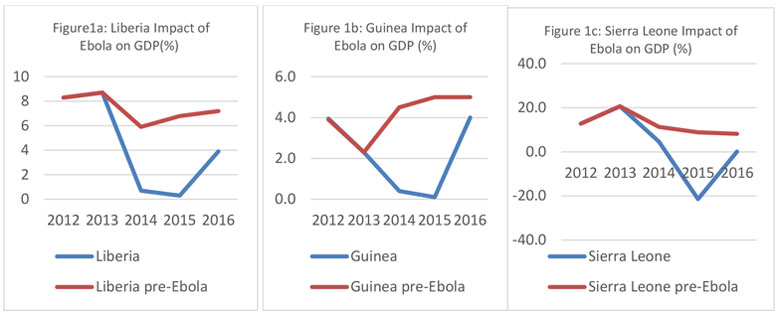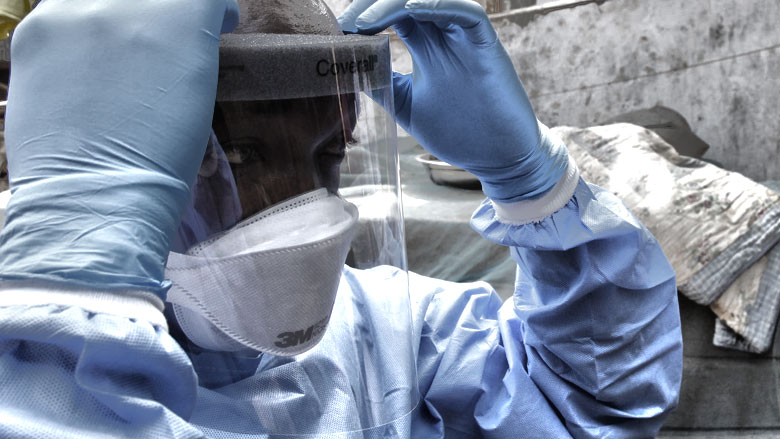KEY FINDINGS
This update presents the World Bank’s final analysis of the economic and fiscal effects of the 2014-2015 West African Ebola epidemic and commodity price shocks across the three most affected countries of Guinea, Liberia, and Sierra Leone. In relation to the Bank’s April 2015 update, this report provides an updated overview of the status of the three economies.
Summary. The overall impact of the Ebola crisis on Guinea, Liberia, and Sierra Leone has been estimated at $2.8 billion ($600 million for Guinea, $300 million for Liberia, and $1.9 billion for Sierra Leone). This includes the shocks in 2014 and 2015, and the projections for 2016 as the economic impact is outlasting the epidemiological impact. The shock has been worsened by the large decline in the world price of iron ore and other commodities, and specifically for Sierra Leone, corporate governance issues in mining.
- The economic and fiscal impact has outlasted the epidemiological impact due to severe shocks to investment, production, and consumption throughout the region, coupled with commodity price shocks. The mortality from the pandemic of those infected has been 60 percent. The mortality per capita has been 5 per 10000, and the GDP impact per capita has been reduced by an average of $125 per person in the three countries.
- The decline in the international price of commodities has impacted the three Ebola countries. Prices of bauxite, iron ore, and gold have declined by 30 to 60 percent compared to their peak values in recent years, exacerbating the Ebola impact. The management of volatility has been challenging for the three countries, especially in light of the adverse effects on fiscal revenue from the commodity price shortfall.
- Mobile phone surveys conducted during the pandemic convey a pernicious effect on households and labor markets including significantly higher unemployment, lost incomes, lower schooling, and less food consumption, which will create substantial challenges. In Liberia, there was a 40 percent decrease in those working since the onset of the crisis (particularly high for women who were working pre-crisis). Close to 10 percent of Guinean households have withdrawn their children from school, with the large majority citing Ebola as the main factor. In Sierra Leone, 9,000 wage workers and 170,000 self-employed workers outside of agriculture are no longer working, while the recovery process starts.
- Economic recovery will be slow due to significant contraction in GDP during the crisis, and will be exacerbated by the global decline in commodities prices. Real GDP growth for 2015 is projected at 0.3 percent for Liberia, 0.1 percent in Guinea, and -21.5 percent for Sierra Leone.
- The overall fiscal impact of the pandemic has been high, leading to declining revenues, increasing Ebola-related and health expenditures, and exacerbation of fiscal deficits. The deficits in 2015 are estimated at 8.5% of GDP in Liberia, 9.4 % in Guinea, and 4.8% in Sierra Leone.
- Large and timely aid inflows have been successful in cushioning the fiscal impact of the pandemic in 2015 amounting to 8.7 percent in Liberia, 1.3 percent in Guinea, and 5.4 percent in Sierra Leone.
- Despite disruption to supply chains as a result of the Ebola crisis, inflation was contained in high single digits in the three economies due in large part to monetary management, resilience in the agricultural sector, and low international prices for fuel and food.
IMPACT ON GDP GROWTH AND INFLATION in Guinea, LIBERIA, and Sierra Leone
- Liberia GDP Growth: Real GDP growth slowed to 0.7 percent in 2014, from 8.7 percent in 2013 (Table 1a), reflecting the twin shocks of Ebola and lower commodity prices. The economy has been very slow to recover, with stagnation in the mining and services sectors. Growth is projected at 0.3 percent in 2016. Over the medium term, the boom in the services sector, together with the restart of public and private investment in infrastructure, will contribute to faster growth. Risks stem from adverse developments in the global economy linked to slower growth in China and possible depressed rubber and iron ore prices.
- Guinea GDP Growth: Real GDP growth in 2015 was 0.1 percent, compared to a pre-Ebola forecast of 4.0 percent (Table 1b). Services had very low growth, while mining contracted, and only agriculture displayed some resilience. In 2016, growth is projected to accelerate to 4.0 percent. Agricultural production should continue to grow at the rapid pace of the previous years, and manufacturing and services should benefit from the resumption of international and domestic travel and trade and the improved electricity supply in Conakry. There are risks due to uncertain policy in the mining sector, low international mineral prices, and investor aversion.
- Sierra Leone GDP Growth: GDP growth of 4.6 percent in 2014 was driven by expanding iron ore production, just as in 2013 when real GDP increased by 20.7 percent (Table 1c). Non-iron ore GDP growth in 2014 slowed sharply on account of the Ebola outbreak to 0.8 percent, from 5.3 percent the previous year. Real GDP in 2015 is estimated to have contracted by -21.5 percent. This is mainly due to the shutdown of iron ore operations and a nascent recovery in non-iron ore GDP led by agriculture, and buoyed by a partial resumption in services especially construction, including the resumption of donor financed capital projects. The recovery is expected to be very slow in 2016 with a projected 0.1 percent growth. Risks relate to the global outlook with a focus on China.

FISCAL ANALYSIS: REVENUES and EXPENDITURES
- Fiscal. Ebola and lower commodity prices have had adverse fiscal effects on the three countries leading to falling revenues, increased Ebola-related spending and widening deficits. The deficits in 2015 are estimated at 8.5% of GDP in Liberia, 9.4 % in Guinea, and 4.8% in Sierra Leone. In all three countries, government revenues declined across the board, including direct taxes on companies, VAT receipts, and indirect taxes, reflecting the generally lower levels of economic activity and reduced levels of compliance. The decrease in private and foreign investment forced governments to step in. Current transfers increased, particularly to finance health care workers and recurrent expenditures. The decline in investors’ confidence put pressure on scarce budgets in all the Ebola countries. Financing gaps for the three core countries reached more than $ 600 million over the two years. The deficits as a share of GDP are estimated at 9.4 percent in Guinea, 8.5 percent in Liberia, and 4.8 percent in Sierra Leone in 2015.
- Aid. Much of the impact of the pandemic and commodity shocks was softened by the relatively large aid flows. In Liberia, grants reached close to 19 percent of GDP for 2014 and 2015, while in Sierra Leone, it was close to 10 percent and in Guinea, it was about 5 percent. Grants helped finance the deficits, especially for Liberia, but it will be unlikely to have similar levels of aid in 2016.
Table 1: Key Fiscal Indicators 2012-2016 (% of GDP) |
|
|
|||||
|
2012 |
2013 |
2014 Prel. |
2015 Est. |
2016 Proj. |
||
LIBERIA |
|
|
|
|
|
||
Total Revenue |
26.4 |
27.7 |
22.4 |
22.5 |
23.1 |
||
Grants |
1.7 |
2.4 |
10.0 |
8.7 |
7.5 |
||
Expenditure |
31.4 |
31.7 |
40.4 |
39.7 |
35.7 |
||
Fiscal balance |
-3.3 |
-1.6 |
-8.0 |
-8.5 |
-5.1 |
||
GUINEA |
|
|
|
|
|
||
Total Revenue |
20.2 |
18.3 |
17.9 |
17.7 |
20.4 |
||
Grants |
2.7 |
1.5 |
4.0 |
1.3 |
4.0 |
||
Expenditure |
26.1 |
25.1 |
26.1 |
28.3 |
25.7 |
||
Fiscal balance |
-3.3 |
-5.2 |
-4.2 |
-9.3 |
-1.3 |
||
SIERRA LEONE |
|
|
|
|
|
||
Total Revenue |
12.2 |
12.7 |
11.1 |
9.8 |
10.4 |
||
Grants |
4.1 |
3 |
4.8 |
5.4 |
3.2 |
||
Expenditure |
21.9 |
17.6 |
20.1 |
20 |
19 |
||
Fiscal balance |
-5.6 |
-1.9 |
-4.2 |
-4.8 |
-5.4 |
||
Sources: Government authorities, World Bank, and IMF estimates. |
|
||||||
